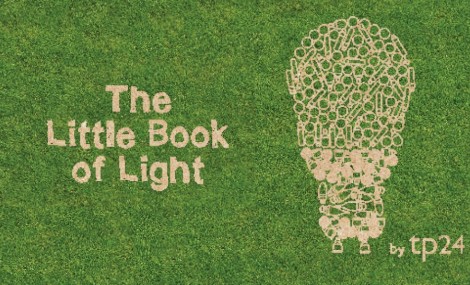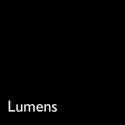
Welcome to the Little Book of Light
At tp24, we are passionate about educating our customers to make sure that they make well-informed decisions regarding the lighting in their home. Whether you know a little or a lot, we’re here to make things a little clearer. This section will take you through all of the core concepts regarding lighting and lamps without the technical jargon.
Please click on a section below to get started.



















Lumens are a measure of light. Typically one lumen is equivalent to the light emanating from a wax candle. A conventional 40 watt light bulb would have a lumen output of around 450lm. A CFL (Compact Fluorescent Lamp) with the same lumen output would only use approximately 9 watts and an LED considerably less depending on the type. As a general guide the efficacy of an incandescent lamp is 10-12 lum/w, a compact fluorescent is around 50-60 lum/w and an LED can vary from 40-90 lum/w. Remember: the higher the lumens the brighter the lamp.

A watt is a measure of power consumption. The wattage of a bulb actually tells you how much electricity it uses, not how much light it produces. Traditionally lamps have always used watts as an indication of the light that can be expected from the bulb. However, with new technology and more efficient lamps, watts are becoming increasingly irrelevant and eventually all lamps will be measured in Lumens.

Voltage is the pressure within the circuit that’s generated by the electricity company from the national grid. Different countries use different voltages according to their infrastructure system, it’s generally referred to as the electrical potential.
In the UK the current used is typically 240 volts, in America 110 volts and in most of Europe and the Far East the current is typically 220 volts.
In general different plug sockets are used to ensure people use the correct equipment relevant to their local current.
A good analogy is to imagine the pressure behind the flow of electrons in a circuit similar to water pressure in a hose.

CRI measures the light quality of a light source as compared with sunlight (which is given the maximum CRI value of 100). The closer a light-source’s CRI is to 100, the better its ability to show true colours. Lamps with a CRI of 85-90 are suited for venues such as art galleries, retail shops and photography where showing a good colour rendition is critical.
In early 2013 a change in European regulations meant that all new LED imported lamps must now have a minimum CRI of 80 for indoor use and 65 for external use. This change has considerably improved the light quality for domestic living spaces.

Correlated Colour Temperature (also known as CCT) describes the appearance of the light in degrees Kelvin. It is the measure of the colour of light emitted; it can be quite yellow (2700k) or very blue white (6500k). In the UK most lamps are 2700k to 3500k.

As electricity passes through the wire in the lamp, friction is generated by the passing of electrons, heating the wire until it glows very brightly.
Approximately 90% of the energy used by an incandescent light bulb is lost in the form of heat with only 10% of its output being actual light.
This technology has not significantly evolved since the original designs were developed over 100 years ago.

A halogen light bulb is an incandescent lamp with a tungsten filament contained within. When combined with an inert gas and a small amount of halogen the chemical cycle deposits evaporated tungsten back onto the filament, extending the life of the bulb. This makes them more efficient than traditional incandescent bulbs, although they are nowhere near as efficient as LEDs or CFLs.
Halogen lamps are generally small (G9, GU10) and generate a lot of heat so can only be used in fittings that will withstand high temperatures. Due to their size, halogen lamps are perfect for smaller light fittings though they lack the sophistication and energy saving attributes of the alternatives.

The central element in a fluorescent lamp is a sealed glass tube. The tube has two electrodes, one at each end, which are wired to an electrical circuit running an alternating current. Inside the tube is a cocktail of mercury and gases (typically argon) which is kept under very low pressure.
When you turn the lamp on, an electrical arc passes through the glass tube; as the arc passes through the mercury in the tube turns from a liquid/solid to a gas.
This combination causes ultraviolet light photons to be released. Our eyes don’t register ultraviolet photons, so it needs to be converted into light the human eye can register. Coated along the inside of the tube is a special phosphor powder that, when combined with ultraviolet light, creates a visible light, making it possible for manufacturers to vary the colour of the light by using different combinations of phosphors.
Specifically in a ‘compact’ florescent lamp the tube is folded to make the lamp smaller and the ballast is normally built in so the lamp can replace the conventional light bulb.

An LED is what’s called “solid-state lighting” technology. Basically, instead of emitting light from a vacuum (as in an incandescent bulb) or a gas (as in a CFL), an SSL emits light from a piece of solid matter. In the case of a traditional LED, that piece of matter is a semiconductor.
Stated very simply, an LED produces light when electrons move around within its semiconductor structure.
A semiconductor is made up of a positively charged and a negatively charged component. The positive layer has “holes” – openings for electrons; the negative layer has free electrons floating around in it. When an electric charge strikes the semiconductor, it activates the flow of electrons from the negative to the positive layer. Those excited electrons emit light as they flow into the positively charged holes.
Early LEDs had quite low outputs but recent improvements have allowed for much better performance. You can now find some LED replacement bulbs for candle & spot lamps and even GLS styles equivalent to a 60w incandescent. Rapid improvements in technology will see prices eventually drop and performances consistantly improve.



At tp24 we have a switching system fitted inside many of our larger statements pieces and some of our smaller fittings. The switch detects a pulse when you turn it on and off at the wall so that you do not need any special wiring. It switches off balanced sections of your fitting, turning off some of the lamps to get the same mood change as dimming but saving more energy.

If you have ever fitted a light fitting before you will be well aware that it can be an unnecessarily fiddly task; with this in mind we have our own patented Halo Speed Ring (HSR) fitting system. Simply leave your ceiling rose on the ceiling and use it to fit your light fitting to the ceiling. The main benefit being you only need to think about swapping the three wires you took out with 3 more! The HSR ring is also adaptable so that if there is not a ceiling rose in place you can still fit your light.
Full fitting instructions are included in the box. Make sure you turn the power off before and contact a qualified electrician if you do not know what you are doing!

PIR or a Passive Infrared Sensor is a sensor we often use on our outdoor lights. It detects movement so that your light will come on when you need it to without having to use a switch. The light will only come on if it is dark enough. Some products can be adjusted for duration times, range and light level, but many are preset.

Ingress Protection Ratings (IP) are an industry standard set of ratings that refer to protection against intrusion. Our products are normally IP20 but some, specifically for different bathroom zones and outdoor purposes are rated IP44 or IP65.
To understand exactly what these ratings mean please click here.
See our diagram for the various bathroom IP requirements.